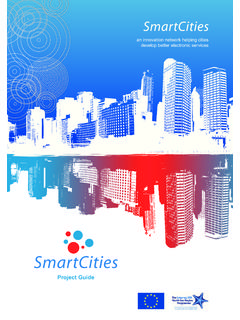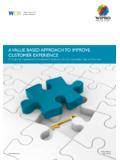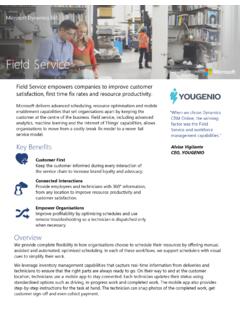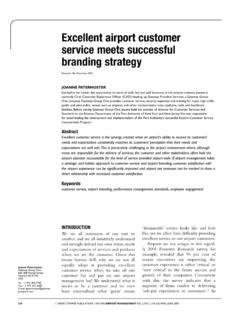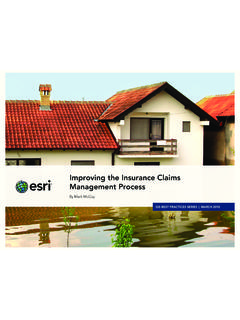Transcription of Improving business processes and delivering …
1 Improving business processes and delivering better e-services A guide for municipalities from Smart Cities Improving business processes and delivering better e-services 1. Contents Introduction 03. Chapter 2. business processes are key 04. The customer 05. business process mapping 07. Planning and execution 08. Chapter 3. Developing the Common Process Model 10. A common language 11. Consistency 12. Chapter 4. Preconditions values and concepts 14. Chapter 5. Why use process mapping? 19. Measuring success 19. Customer-centricity 22. Scoping the project 24. What and how to model, measure and re-design 26. Communicating process maps 27. Map making 29. The improvement challenge 30. Support from management 34. business process maturity 36. Chapter 6. From processes to e-services 38.
2 Chapter 7. References 39. 2 Improving business processes and delivering better e-services 1. Introduction Do you know your business and e-service solutions? Is your IT aligned with your business to support, enable and deliver your services? Your business processes define your ability and potential to provide customers and employees with effective and high quality services and solutions. Your processes influence your performance, your service delivery and what administrative support is available for your service offerings. This document outlines a model, or framework, which can help you to improve your existing business processes to support and develop your e-services. The Common Process Model comprises a set of preconditions, directives, guidelines and templates that will help employees in different roles to identify, measure and improve the performance of the business processes that make up your e-service solutions.
3 The Common Process Model stems from a collaborative project between Karlstad University and the municipality of Karlstad in Sweden, that began in February 2009. The project aimed to develop a simple methodology that would help the municipality to think about, to describe and to improve its business processes in a logical, strategic and self-reflective manner. The Common Process Model is largely based on research and the experiences of employees from the municipality of Karlstad, but has been enhanced and refined by contributions from local authorities in Edinburgh, Groningen, Kortrijk, Kristiansand and Lillesand. These partners of Smart Cities', a project part-funded by the Interreg IVB North Sea Region Programme of the European Union, first described their business processes and improvement initiatives in a series of project initiation documents ( see ); these were used to share knowledge and experiences among the project partners and formed the basis of discussions and documentation for a Smart Cities workshop on business processes held in Karlstad in September 2010.
4 The Smart Cities project is an innovation network made up of 13 governments and academic partners from six countries who are working to improve the development and take-up of e-services and e-government across Europe's North Sea region. Project partners are Improving their e-services delivery by rethinking the basics of service delivery, by working with academic and research partners, by changing their innovation methodologies, and by transferring their best practices to other project partners. This guide is one of many outputs from the Smart Cities project which disseminate the project's findings on the models, the tools and the techniques that can be used to improve municipal service delivery. The guidance in this publication on business processes is based on critical modelling factors, focused and reflective modelling and practical process modelling ( Christiansson and Christiansson, 2006) performed during the Smart Cities project between 2009 and 2011.
5 Marie-Therese Christiansson, Assistant Professor in Information Systems at Karlstad University is the author of this guide. Improving business processes and delivering better e-services 3. 2. business processes are key Every municipality wants to develop its business , to improve the performance of its daily operational work and the quality of its service delivery. business processes are the operational activities that provide, produce and deliver its services, with or without an e (electronic/digital support). Every organisation consists of professional employees who perform business operations, using a variety of different resources and with different levels of information technology (IT) support. E-services are the collection of administrative processes that enable governments and municipalities to provide services for their customers (citizens, visitors, companies and other government agencies).
6 Through web sites. E-services allow customers to interact with municipalities via the internet; they can ask questions, receive answers and updates on government regulations, obtain official government documents, file applications, pay taxes and bills, and receive payments, to list just a few of the e-services that are commonly delivered by European municipalities. Governments have placed a lot of emphasis on e-services as a way to improve service delivery. But business development requires a much broader view that goes beyond the front end website; it is essential to consider all the behind-the-scenes' business processes and what goes on in the back office. It is important to review all the business processes that affect the performance of a service in order to improve daily life for both employees and customers.
7 Case Study Lillesand uses processes to develop e-services The town of Lillesand in Norway has been working to increase the use of digital application forms to make it easier for citizens to access services and interact with the municipality whilst reducing the administrative burden on its own employees. The municipality described and identified 20 business processes in its documentation system; it realised that many of these could be digitalised'. Lillesand now has a service on its municipal website where citizens can access their case files and see the status of their queries or applications. This tracking service has been achieved by describing and reengineering the processes associated with digital forms, along with specifically designed databases and data warehousing, and integrating digital archives and publishing across multiple channels.
8 Most of the communication with the municipality's residents is now via digital formats, as are most of the administrative tasks required from municipal employees and community service industries. 4 Improving business processes and delivering better e-services The customer The customer has a key role to play in Improving e-services. They participate in the business process for example by triggering a process when they submit an online request via a website. But their involvement goes much further. Not only do they request a service and receive information, but they also act as a co-producer and have an influence on the service performance, depending on their ability and experience of the service at different points in the delivery process. It is possible to define and map business operations in the form of processes , but it is important to do this from the perspective of those who will use the maps to improve performance and who need to identify how process reengineering could add value to the customer.
9 The purpose of process mapping is to acquire knowledge about operations across a service or organisation, which can then be used to make informed decisions about improvement measures (see Figure 1). Service Requirement delivery 24/7. Time Decision Time Action - Action - Action - in dep/org. in dep/org. in dep/org. Trigger Action Action Result Customer object object Customer Action - in dep/org. Process Actor/Role Actor/Role Website System Phone Email Actor/Role Actor/Role Figure 1. Elements in a business process Figure 1 shows the elements of a typical business process. An assignment or case is triggered following a request from a customer; different business rules/logic ( decisions and coherent activities in an information/communication workflow) are then applied by various actors in and across the administration.
10 Employees in a professional role or customers perform business operations (actions), using IT to support and enable their actions across different digital channels. A service is delivered in the form of an answer, a fulfilled request or completed assignment when the business processes and communication/workflows perform well. Improving business processes and delivering better e-services 5. When we look at a mapped business process, we can then begin to ask questions about potential improvements: Which channels are the customers using to request or contact your service? For each step in the business process - who is the service provider the customer, employees or IT solutions? - what is being communicated is information being requested or provided? - what channel is being used phone, face-to-face, email or online forms?


